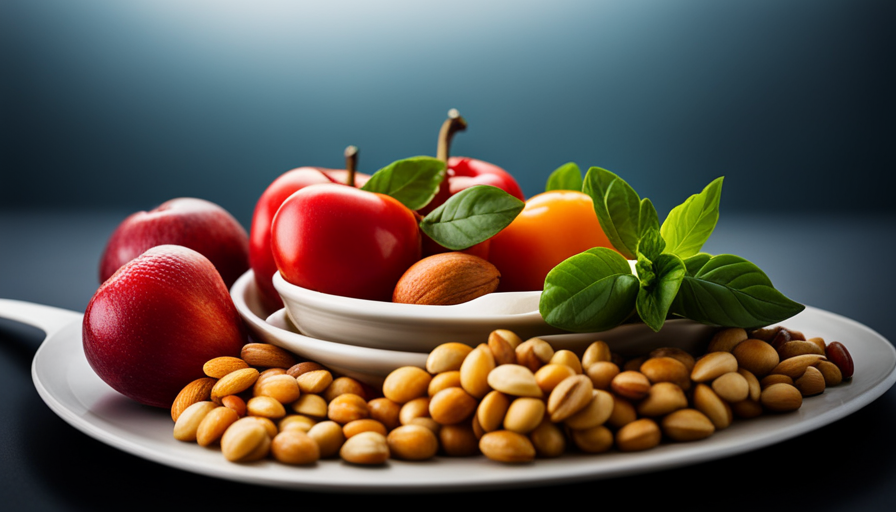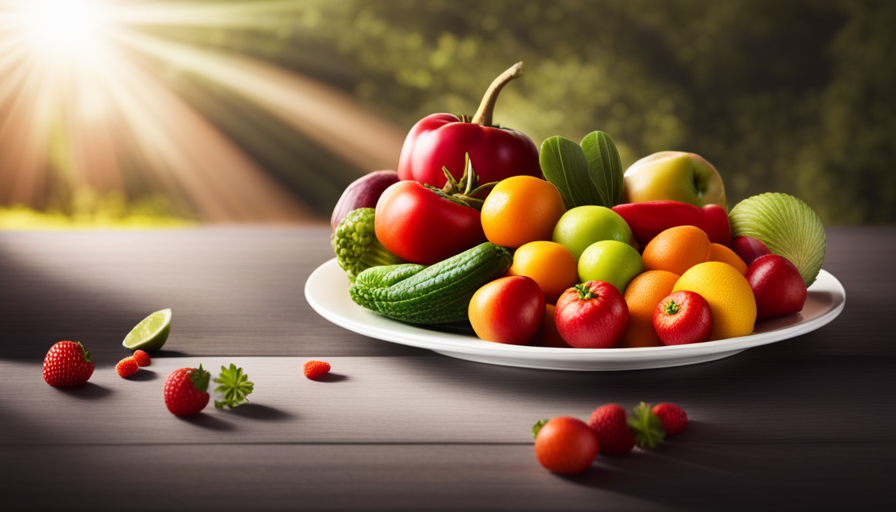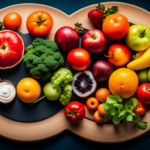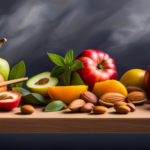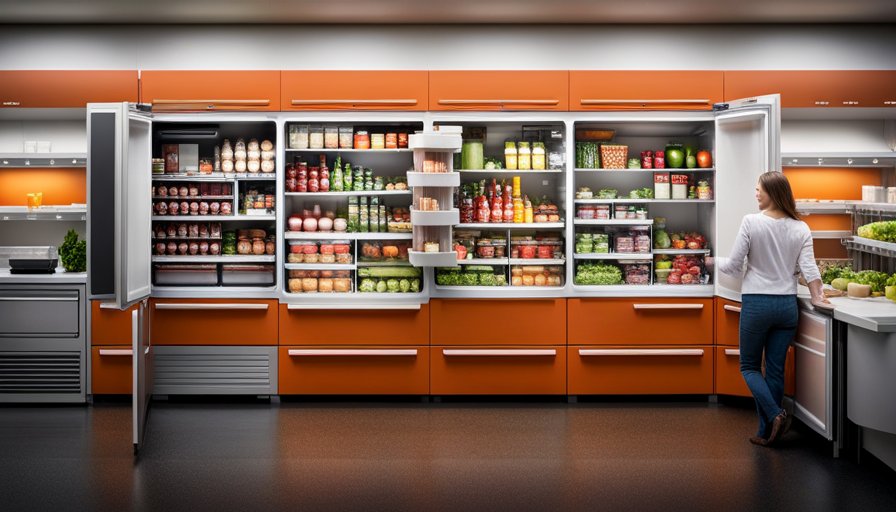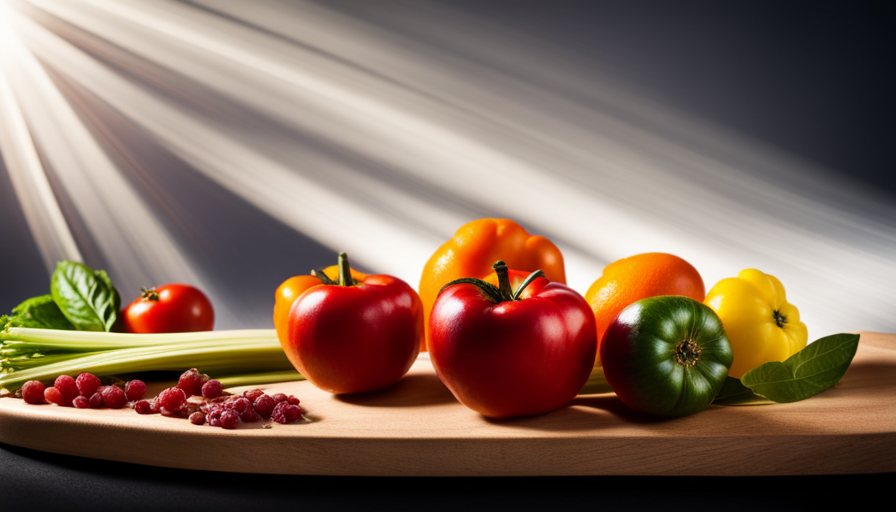The raw food diet is praised for its emphasis on natural, unprocessed foods, but it can present challenges in meeting essential nutrient needs. While it can help increase fruit and vegetable consumption, there is a greater risk of deficiencies in important vitamins and minerals.
It is important to be aware of these potential shortcomings and take proactive steps to ensure adequate nutrient intake. In this article, I will explore the deficiencies that may arise from following a raw food diet and discuss strategies to overcome them. From balancing macronutrients to considering the impact of food preparation methods, we will delve into the various factors that can impact nutrient availability.
Whether you are considering a raw food diet or are already following one, this article will provide valuable insights to help you optimize your nutritional status and overall health.
Key Takeaways
- The raw food diet may pose a higher risk for deficiencies in key vitamins and minerals.
- Vitamin B12 and vitamin D are commonly lacking in a raw food diet.
- Zinc, iron, and calcium may not be adequately provided by a raw food diet.
- Pregnant women and children on a raw food diet may face nutrient deficiencies, particularly in iron, calcium, and vitamin B12.
Essential vitamins and minerals that may be lacking in a raw food diet
If you’re following a raw food diet, you might be missing out on essential vitamins and minerals that your body needs. While raw foods can provide a wealth of nutrients, there are certain vitamins and minerals that may be lacking in this type of diet.
One potential deficiency is vitamin B12, which is primarily found in animal products. Since raw food diets typically exclude animal products, it can be challenging to obtain enough vitamin B12 solely from plant-based sources.
Another potential deficiency is vitamin D, as it is mainly synthesized in the body through exposure to sunlight and is found in limited amounts in raw plant foods.
Additionally, raw food diets may not provide adequate amounts of zinc, iron, and calcium, as certain plant-based sources of these nutrients may not be as bioavailable as their cooked counterparts.
It’s also important to consider potential interactions between certain nutrients. For example, the absorption of iron from plant foods can be enhanced by consuming foods high in vitamin C, which is commonly found in cooked vegetables.
To ensure adequate nutrient intake on a raw food diet, it’s important to employ strategies for nutrient absorption and consider potential interactions between certain nutrients.
Transitioning into the subsequent section, let’s explore some strategies to ensure you’re getting enough essential vitamins and minerals while following a raw food diet.
Strategies to ensure adequate nutrient intake
To ensure optimal nutrient intake, it’s important to implement effective strategies while following a raw food eating plan. One strategy for maximizing nutrient bioavailability is to soak or sprout raw nuts, seeds, and legumes. This process helps to break down the phytic acid, which can inhibit the absorption of minerals such as iron, zinc, and calcium.
Soaking grains and beans can also make them easier to digest and increase the availability of nutrients. Another strategy is to include fermented foods in your raw food diet. Fermentation enhances the bioavailability of certain nutrients and promotes the growth of beneficial bacteria in the gut. Foods like sauerkraut, kimchi, and kefir are rich in probiotics, which can aid in nutrient absorption and improve digestion.
Additionally, combining certain foods can optimize nutrient absorption. For example, pairing foods rich in vitamin C, like citrus fruits or bell peppers, with iron-rich foods like leafy greens or seeds can increase iron absorption. Similarly, consuming foods high in vitamin D, such as mushrooms or fortified plant-based milks, with sources of calcium can enhance calcium absorption.
Implementing strategies for nutrient absorption and maximizing nutrient bioavailability is crucial when following a raw food diet. By soaking or sprouting nuts and seeds, incorporating fermented foods, and combining nutrient-rich foods, you can ensure that you’re getting the most out of your raw food eating plan. This sets the stage for the subsequent section on the importance of balancing macronutrients.
Importance of balancing macronutrients
When it comes to balancing macronutrients, there are three key points that I believe are crucial.
First and foremost, ensuring sufficient protein intake is essential for overall health and wellbeing.
Including healthy fats in the diet is also important as they provide energy, support cell function, and aid in the absorption of certain vitamins.
Lastly, managing carbohydrate sources is crucial to maintain stable blood sugar levels and prevent spikes and crashes in energy throughout the day.
By focusing on these key points, we can ensure a well-rounded and balanced macronutrient intake.
Ensuring sufficient protein intake
Although the raw food diet may seem nutrient-rich, it can still lead to potential protein deficiencies. It’s important to ensure sufficient protein intake when following this diet.
Here are some strategies for plant-based protein sources that can help meet protein needs:
-
Legumes: Foods like lentils, chickpeas, and black beans are excellent sources of protein.
-
Nuts and seeds: Almonds, chia seeds, and hemp seeds are all high in protein and can be easily incorporated into meals or snacks.
-
Quinoa: This grain is a complete protein, meaning it contains all essential amino acids.
While it’s important to get enough protein, excessive protein intake can also have risks. It can strain the kidneys and potentially lead to nutrient imbalances. Therefore, it’s crucial to find a balance and not rely solely on protein sources.
Transitioning into the next section, including healthy fats in the diet is another important aspect of maintaining a well-rounded raw food diet.
Including healthy fats in the diet
Including healthy fats in the diet is essential for a well-rounded raw food lifestyle. Interestingly, consuming adequate amounts of healthy fats has been shown to reduce the risk of heart disease by up to 30%.
Healthy fat sources in a raw food diet include avocados, nuts, seeds, and cold-pressed oils. These fats are rich in omega-3 fatty acids, which have been linked to numerous health benefits, including improved brain function and reduced inflammation.
Additionally, healthy fats help the body absorb fat-soluble vitamins, such as vitamins A, D, E, and K, which are essential for overall health. It is important to include a variety of healthy fat sources in the raw food diet to ensure adequate intake.
Transitioning into managing carbohydrate sources, it’s also crucial to choose nutrient-dense options to maintain a balanced raw food lifestyle.
Managing carbohydrate sources
Now that we’ve discussed the importance of including healthy fats in the raw food diet, let’s talk about managing carbohydrate sources.
When following a raw food diet, it’s crucial to carefully manage fruit intake. While fruits are a great source of natural sugars, consuming too much can lead to an imbalance in blood sugar levels and potentially hinder weight loss efforts. It’s recommended to choose lower glycemic fruits such as berries and limit high glycemic fruits like bananas.
Additionally, incorporating fermented foods into the diet can provide beneficial carbohydrates and promote gut health. Fermented foods such as sauerkraut, kimchi, and kombucha contain probiotics that can aid in digestion and boost the immune system.
Transitioning to the next section, it’s important to be aware of the potential risks for pregnant women and children on a raw food diet.
Potential risks for pregnant women and children on a raw food diet
Pregnant women and children on a raw food diet may face a higher risk for nutrient deficiencies. The potential risks of a raw food diet during pregnancy include inadequate intake of essential nutrients such as iron, calcium, and vitamin B12. Iron is crucial during pregnancy to support the increased blood volume and prevent anemia, while calcium is essential for the developing baby’s bones and teeth. Vitamin B12 is necessary for neurological development and can only be obtained from animal sources or fortified foods.
Additionally, the impact of a raw food diet on a child’s growth and development is a concern. Raw food diets are often low in calories, protein, and fat, which are vital for a child’s growth. Insufficient calorie intake can lead to inadequate weight gain and hinder proper development. Protein is essential for building and repairing tissues, while fat is crucial for brain development and nutrient absorption.
Transitioning to the subsequent section about the impact of food preparation methods on nutrient availability, it is important to consider how different cooking techniques can enhance nutrient absorption and availability.
Impact of food preparation methods on nutrient availability
Roasting vegetables brings out their natural flavors and creates a mouthwatering aroma that makes them irresistible. However, it’s important to consider the impact of cooking methods on nutrient bioavailability. When vegetables are cooked, their cell walls break down, making it easier for our bodies to access the nutrients within.
This is especially true for certain nutrients, such as lycopene in tomatoes or beta-carotene in carrots. Cooking can also increase the availability of minerals like calcium and iron, which are bound to compounds that hinder their absorption in raw foods.
Enzymes play a crucial role in raw food digestion. Raw fruits and vegetables contain enzymes that help break down the food during digestion. However, cooking destroys these enzymes, making it more difficult for our bodies to digest raw foods and absorb the nutrients they contain.
While the raw food diet may have some health benefits, it’s important to be mindful of the potential impact of food preparation methods on nutrient availability.
In the next section, we will discuss the importance of monitoring and addressing any signs of deficiency that may arise from following a raw food diet.
Monitoring and addressing any signs of deficiency
When it comes to monitoring and addressing any signs of deficiency, I believe it’s important to regularly get blood tests to assess nutrient levels.
This way, I can have a clear understanding of my body’s needs and potential deficiencies.
Additionally, working with a healthcare professional can help me develop a personalized plan to address any deficiencies that may arise, ensuring that I’m getting the right nutrients for optimal health.
Regular blood tests to assess nutrient levels
Regular blood tests can help individuals on the raw food diet assess their nutrient levels. These tests are an important tool for monitoring nutrient deficiencies that may arise from a diet that excludes cooked and processed foods. By measuring levels of key nutrients in the blood, such as vitamins, minerals, and essential fatty acids, individuals can identify any imbalances and take appropriate actions to address them.
To further illustrate the significance of regular blood tests in nutrient assessment, the following table provides examples of nutrients commonly found in raw foods and their corresponding functions in the body:
| Nutrient | Function |
|---|---|
| Vitamin C | Supports immune function and collagen synthesis |
| Iron | Essential for oxygen transport and energy production |
| Vitamin B12 | Required for nerve function and DNA synthesis |
| Omega-3 fatty acids | Promotes heart health and reduces inflammation |
| Calcium | Important for bone health and muscle function |
By regularly monitoring nutrient levels through blood tests, individuals can proactively identify deficiencies and work with a healthcare professional to address them effectively. This collaborative approach ensures that any potential nutrient gaps can be addressed promptly and appropriately.
Working with a healthcare professional to address deficiencies
To effectively address any nutrient deficiencies, it’s crucial for you to collaborate with a healthcare professional who can guide you like a compass through the complex terrain of your health journey.
When working with a healthcare professional, they may suggest strategies for meal planning that can help ensure you’re getting all the necessary nutrients on a raw food diet. These strategies may include incorporating a variety of fruits, vegetables, nuts, and seeds into your meals to maximize nutrient intake. Additionally, they may advise you to consider potential risks for athletes on a raw food diet, such as inadequate protein intake or insufficient energy for high-intensity exercise.
By working with a healthcare professional, you can develop a personalized plan that addresses your specific needs and minimizes the risk of nutrient deficiencies.
Moving forward, it’s important to understand the importance of variety in a raw food diet.
Importance of variety in a raw food diet
When it comes to following a raw food diet, it’s important to explore a wide range of fruits, vegetables, and nuts. This allows for a diverse intake of nutrients that can support overall health and well-being.
Additionally, incorporating different colors and textures into meals adds not only visual appeal but also a variety of beneficial compounds that contribute to optimal nutrition.
By embracing variety in a raw food diet, individuals can ensure they’re receiving a wide array of essential vitamins, minerals, and antioxidants.
Exploring a wide range of fruits, vegetables, and nuts
Exploring a variety of fruits, vegetables, and nuts is a great way to indulge in the vibrant flavors and nourish your body on a raw food diet. Here are three ways to enjoy this subtopic:
-
Discovering new taste preferences: Trying different fruits, vegetables, and nuts can help you find flavors you love and expand your palate. From sweet and juicy mangoes to creamy and rich avocados, there are endless possibilities to explore.
-
Experimenting with new recipes: Incorporating a wide range of fruits, vegetables, and nuts into your raw food diet opens up a world of recipe options. From refreshing salads and smoothies to satisfying raw desserts, there are countless ways to get creative in the kitchen.
-
Enjoying the health benefits: Each fruit, vegetable, and nut brings its unique set of nutrients, vitamins, and minerals to the table. By incorporating a diverse range of these foods, you’re maximizing your nutrient intake and supporting optimal health.
By incorporating different colors and textures for optimal nutrition, you can further enhance the benefits of a raw food diet.
Incorporating different colors and textures for optimal nutrition
By incorporating a vibrant array of colors and textures into your plate, you can create a delicious and visually appealing feast that nourishes your body like a vibrant garden in full bloom.
When following a raw food diet, it’s important to incorporate different flavors and textures to ensure optimal nutrition. Including a variety of fruits, vegetables, and nuts in different colors ensures that you’re getting a wide range of vitamins, minerals, and phytonutrients.
Additionally, incorporating fermented foods such as sauerkraut, kimchi, or tempeh provides beneficial probiotics that support gut health and digestion. These fermented foods are rich in enzymes and beneficial bacteria that aid in breaking down the raw foods and improving nutrient absorption.
By incorporating different flavors and textures into your raw food diet, you can enhance your overall nutrition and promote healthy digestion. This is essential for managing potential digestive challenges and ensuring optimal health.
Managing potential digestive challenges
To effectively address potential digestive challenges, it’s important to understand the impact of the raw food diet on nutrient deficiencies. While the raw food diet can provide many health benefits, it does come with certain risks, including a higher potential for developing deficiencies in certain nutrients.
One of the main concerns is the risk of potential food allergies and managing food intolerances. Raw food diets often include a wide variety of fruits, vegetables, nuts, and seeds. While these foods are generally nutritious, they can also be common triggers for food allergies and intolerances. For example, some individuals may have difficulty digesting raw nuts or certain fruits, leading to digestive discomfort or allergic reactions. It’s important to be aware of these potential challenges and manage them accordingly.
To mitigate the risk of nutrient deficiencies and manage potential digestive challenges, it’s recommended to incorporate a diverse range of foods into the raw food diet. This can help ensure a greater intake of essential nutrients and reduce the likelihood of developing deficiencies. Additionally, it’s important to listen to your body and pay attention to any signs of discomfort or adverse reactions.
While the raw food diet can be beneficial for overall health, it’s important to be mindful of potential food allergies and intolerances. By incorporating a variety of foods and being aware of individual dietary needs and preferences, it is possible to enjoy the benefits of a raw food diet while minimizing the risk of nutrient deficiencies.
Considering individual dietary needs and preferences
Considering your individual dietary needs and preferences can help you create a raw food eating plan that’s enjoyable and fulfilling. When it comes to following a raw food diet, it’s important to take into account any individual dietary restrictions you may have.
Some individuals may have allergies or intolerances to certain foods, which can limit their options within the raw food realm. However, there are alternative raw food options available to suit a variety of dietary needs.
Here are three examples of alternative raw food options that can be incorporated into your diet:
-
Nut milks: If you’re lactose intolerant or follow a vegan diet, nut milks such as almond milk or cashew milk can be a great alternative to traditional dairy milk. These milks can be made by blending soaked nuts with water and straining the mixture.
-
Seed butters: If you have a nut allergy, seed butters such as sunflower seed butter or pumpkin seed butter can provide a similar creamy texture and nutty flavor. These can be spread on raw crackers or used as a dip for fruits and vegetables.
-
Raw sprouted grains: If you follow a gluten-free diet, sprouted grains like quinoa, buckwheat, or amaranth can be a nutritious and versatile addition to your raw food meals. Sprouted grains are easier to digest and provide essential nutrients.
Considering your individual dietary needs and preferences can help you tailor your raw food diet to suit your unique requirements. However, it’s always important to seek guidance from a qualified nutritionist or dietitian to ensure you’re meeting all your nutritional needs.
Seeking guidance from a qualified nutritionist or dietitian
Seeking guidance from a qualified nutritionist or dietitian can ensure that you receive personalized advice on how to meet your unique dietary needs and preferences. When it comes to following a raw food diet, it’s important to understand the potential benefits as well as the common misconceptions associated with this eating pattern.
A raw food diet primarily consists of consuming unprocessed, uncooked fruits, vegetables, nuts, seeds, and sprouted grains. Proponents of this diet believe that it can lead to improved digestion, increased energy levels, and better overall health. However, it’s essential to note that a raw food diet may be deficient in certain nutrients.
One of the major concerns with a raw food diet is the potential risk for nutrient deficiencies. Since this diet restricts the consumption of cooked foods, it can be challenging to meet your daily requirements for certain nutrients such as vitamin B12, iron, calcium, and omega-3 fatty acids. These nutrients are commonly found in animal products, which are typically excluded from a raw food diet. Therefore, it’s crucial to work with a qualified nutritionist or dietitian to ensure that you’re getting adequate amounts of these essential nutrients through alternative sources or supplementation.
While a raw food diet may have its benefits, it’s important to be aware of the potential deficiencies that can arise from this eating pattern. Seeking guidance from a qualified nutritionist or dietitian can help you navigate these challenges and ensure that you’re meeting your unique dietary needs and preferences in a healthy and balanced way.
Frequently Asked Questions
Can a raw food diet provide all the necessary vitamins and minerals for optimal health?
Yes, a raw food diet can meet nutritional needs and provide all necessary vitamins and minerals for optimal health. However, it’s important to ensure a well-balanced and varied diet to avoid deficiencies. While some argue that supplementation is necessary on a raw food diet, it’s possible to obtain all essential nutrients from a carefully planned diet that includes a wide variety of fruits, vegetables, nuts, and seeds. Consulting with a registered dietitian can help ensure nutritional needs are met.
What are the potential risks for pregnant women and children following a raw food diet?
As the saying goes, "You are what you eat." When it comes to the potential risks of a raw food diet for pregnant women and children, it’s important to consider their unique nutritional needs.
While a raw food diet can offer many health benefits, it may also pose risks. Pregnant women and children on a raw food diet may be at higher risk for deficiencies in essential nutrients such as iron, calcium, vitamin B12, and omega-3 fatty acids.
It’s crucial for them to consult with healthcare professionals to ensure adequate nutrient intake.
How can individuals on a raw food diet ensure they are getting enough macronutrients?
To ensure nutrient intake while following a raw food diet, I face some challenges. Since a raw food diet primarily consists of uncooked fruits, vegetables, nuts, and seeds, it can be lower in certain macronutrients like protein and healthy fats.
To overcome this, I incorporate plant-based sources of protein such as legumes and quinoa, and include healthy fats from avocados and nuts. It’s also important to vary my food choices to ensure a wide range of nutrients.
Are there specific food preparation methods that can optimize nutrient availability in a raw food diet?
Optimizing nutrient availability in a raw food diet is crucial for meeting nutritional needs. The importance of food preparation cannot be overlooked in this regard. Certain methods can enhance the bioavailability of nutrients in raw foods.
Soaking, sprouting, and fermenting can increase the digestibility and absorption of nutrients. Additionally, blending or juicing fruits and vegetables can break down cell walls, making nutrients more accessible. By employing these preparation techniques, individuals on a raw food diet can maximize their nutrient intake.
How can individuals on a raw food diet identify and address signs of nutrient deficiencies?
To identify and address signs of nutrient deficiencies while on a raw food diet, I can start by monitoring my body for common symptoms such as fatigue, weakness, and poor immune function.
Regular blood tests can help identify specific nutrient deficiencies. If deficiencies are detected, I can address them by incorporating nutrient-rich foods into my diet, considering supplements if necessary, and consulting with a healthcare professional or registered dietitian for personalized guidance.
It’s important to prioritize a well-balanced diet to support optimal health on a raw food diet.
Conclusion
In conclusion, it’s crucial to acknowledge that following a raw food diet may pose certain challenges in terms of nutrient deficiencies. While this diet promotes a natural and unprocessed approach to eating, it’s important to be aware of the potential risks and take necessary precautions.
By ensuring a variety of foods, balancing macronutrients, and considering individual dietary needs, one can mitigate these concerns. Seeking guidance from a qualified nutritionist or dietitian can provide valuable support in managing any potential deficiencies.
Overall, being mindful of nutrient intake is essential for maintaining a healthy and balanced raw food diet.

